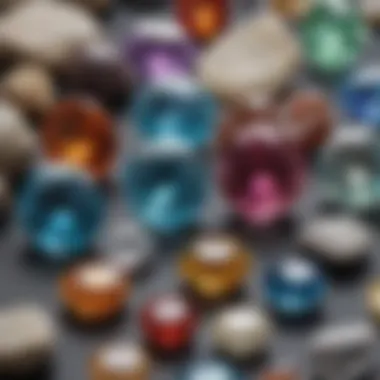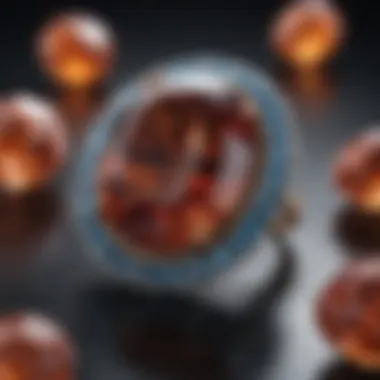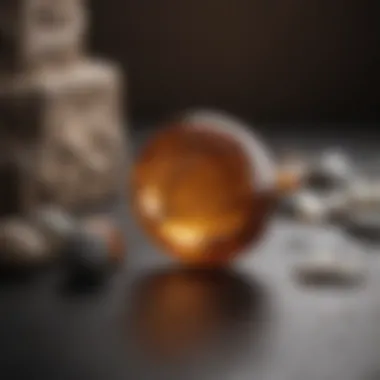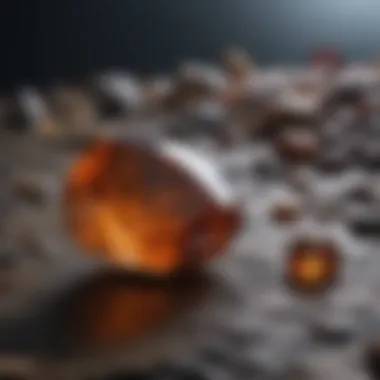A Comprehensive Guide to Gemstone Glue for Artisans


History and Origins
The adhesive used to bond gemstones has a rich history, reflecting both human ingenuity and artistic expression. Gemstone glue has evolved through centuries, driven by the need to create lasting connections between stones and their settings. Ancient civilizations, such as the Egyptians and Romans, utilized natural adhesives like tree resins, animal glues, and bitumen for their intricate jewelry. These early forms of adhesive were not only practical but also indicated the cultural significance of gemstones in spiritual and decorative contexts.
Overview of Collectibles, Rocks, and Fossils
Gemstones, fossils, and collectible rocks carry significant value for both aesthetic pleasure and educational purposes. The emergence of these items as collectibles can be traced back to the fascination humans have had with the earth’s natural wonders. Gemstones are often appreciated for their rarity, beauty, and the skills involved in creating jewelry. Meanwhile, fossils serve as a glimpse into our planet's biological history. Collectors often pursue these items not just for enjoyment but also as investments, making the appropriate use of adhesives critical to preserving their value and appearance.
Historical Significance and Cultural Impact
Throughout history, the way gemstones and fossils were bonded reflects larger cultural narratives. For instance, in Ancient Egypt, gemstones were believed to have protective powers, and artisans took great care to select the right adhesives to ensure the durability of the pieces. In many ancient cultures, the act of bonding stones was seen as a sacred ritual, highlighting the importance of craftsmanship. In today's global market, gemstones continue to hold cultural significance, influencing fashion and decorative art, which in turn shapes contemporary adhesive technologies.
Identification and Classification
Identifying the right type of glue for specific gemstones or fossils is essential for collectors and artisans alike. The following sections provide guidance on how to differentiate between materials based on their properties and applications.
Guide to Identifying Rocks and Fossils
Understanding the characteristics that define various types of gemstones and fossils assists in selecting the appropriate adhesive. Attributes such as hardness, porosity, and surface texture influence adhesion quality. Collectors often refer to stratification or mineral identification guides to help classify their finds accurately.
"Proper identification of gems and fossils not only fosters a deeper appreciation but also ensures that the right adhesives are used to preserve their integrity."
Common Types and Variations
Several types of adhesives are utilized in the application of gemstone bonding. Each one varies in chemical composition and suitability for different materials:
- Epoxy Resins: Strong and durable, suitable for most gemstones.
- Cyanoacrylate (Super Glue): Quick-drying and easy to apply, ideal for minor repairs.
- Silicone Adhesives: Flexible and water-resistant, suitable for porous stones.
- Polyurethane Glues: Versatile, providing a strong bond on a variety of materials.
Understanding these types aids in choosing the most effective glue based on the application and type of gemstone. Each adhesive's specific properties affect the final result, influencing both longevity and aesthetic appeal.
Foreword to Gemstone Glue
In the intricate world of gemstone work, adhesives play a vital role. Understanding gemstone glue's applications, properties, and types is essential for anyone engaged in jewelry making, restoration, or design. This section aims to highlight the definitions and importance of gemstone glue, emphasizing its relevance in both practical and aesthetic aspects of gemstone usage.
Moreover, it is also crucial to consider how the right adhesive not only ensures durability but also enhances the overall appearance of the gemstone pieces. The following subsections dive deeper into the specific elements related to gemstone glue.
Definition and Purpose
Gemstone glue, simply put, is an adhesive specifically formulated for bonding gemstones to various materials, including metal, wood, and synthetic components. This type of glue serves multiple purposes, from assembling jewelry pieces to repairing broken items. The essential function of gemstone glue lies in its ability to create a strong bond that can withstand the test of time and environmental conditions.
Each type of gemstone requires a corresponding adhesive that accommodates its unique properties. For instance, some gemstones are porous and may not hold up well with certain adhesives, while others can tolerate harsher bonding agents. The choice of gemstone glue is, therefore, paramount and should be based on the specific requirements of the material being bonded.
The Importance of Adhesives in Gemstone Work
Adhesives fulfill a crucial role in the craft of working with gemstones. Without them, the integrity of many jewelry designs would be compromised. Some gemstones, especially the softer or more fragile varieties, need special attention when being worked on. An appropriate adhesive not only secures the gemstones but also preserves their beauty and structural integrity.
The selection of the right adhesive involves several considerations:
- Compatibility with gemstone material
- Resistance to environmental factors like humidity and temperature
- Aesthetic finish, affecting how the final piece looks when completed
For collectors and artisans alike, understanding the nuances of various adhesives is essential for ensuring the longevity and quality of their creations.
"Choosing the appropriate adhesive can make the difference between a masterpiece and a flawed piece that cannot withstand daily use."
Through careful selection of gemstone glue, one can enhance not just the functionality of the piece but also its aesthetic appeal, ensuring it remains beautiful for years to come.
Types of Gemstone Glue
Understanding the various types of gemstone glue is crucial for collectors and artisans dealing with jewelry and decorative pieces. Different adhesives serve specific purposes, and selecting the right one can affect the durability and appearance of your work. Each category of adhesive offers distinct benefits and considerations that should align with the characteristics of the gemstones involved. This nuanced approach to choosing the adhesive can lead to better outcomes in both aesthetic and functional aspects of the bonded items.
Jewelry-Specific Adhesives
Jewelry-specific adhesives play a vital role in ensuring that gemstones remain securely fixed in place. These adhesives are formulated to accommodate the unique demands of the jewelry-making process. Factors such as weight, size, and the impact of wear must be considered. Products like E6000 and Aleene’s Original Tacky Glue are popular among artisans because they can bond various materials. They typically offer flexibility, which is important for jewelry that may experience movement. Moreover, these glues often dry clear, providing a seamless finish that complements the natural beauty of the gemstones.
Gel-based Adhesives
Gel-based adhesives provide a thicker consistency, making them ideal for vertical surfaces or complex designs. Their thickness prevents dripping, allowing for more controlled applications. Products such as Gorilla Super Glue Gel are notable for their ability to bond quickly while offering some resistance to impact. For collectors and artisans, using gel-based adhesives can simplify intricate designs and allow more time to adjust stones before the glue sets. However, understanding the drying times is essential, as some gel adhesives may require longer curing periods.
Epoxy Resins for Gemstone Bonding


Epoxy resins are highly versatile and regarded for their strength and durability. These two-part adhesives include a resin and a hardener that create a robust bond when mixed. Epoxy, such as Devcon or West System, is favored in applications where lasting hold is essential. They are useful for larger stones or heavy settings that endure stress. Additionally, epoxies are temperature resistant, making them suitable for items exposed to heat or moisture. While they offer superior bonding power, the curing time can be longer than other types, which requires planning in terms of project timelines.
Cyanoacrylate (Super Glue)
Cyanoacrylate, commonly known as Super Glue, is a fast-acting adhesive that is ideal for quick repairs and bonding because of its rapid drying times. Products like Loctite Super Glue are very popular among hobbyists. However, it is important to note that while this glue sets quickly, it can be brittle once it cures, which may not be ideal for all applications. This bond may not hold against significant stress, but for lightweight or temporary configurations, it is practical. Users need to ensure that both surfaces are clean and dry for optimal results.
Polyurethane Adhesives
Polyurethane adhesives, such as Gorilla Glue, are notable for their expansion properties, which can fill gaps in the bonded surfaces. This makes them effective when working with porous or uneven materials. Polyurethane adhesives can create strong, permanent bonds suitable for outdoor items due to their water-resistant features. However, caution is advised, as the expansion can sometimes lead to excess adhesive that may require cleanup after curing. As with any adhesive, understanding the requirements of the specific application is essential to achieve the desired results.
Choosing the Right Gemstone Glue
Choosing the right gemstone glue is a crucial aspect in the art and science of working with gemstones. It ensures the durability and aesthetics of the final product. The adhesive you select can significantly affect the bond strength, appearance, and longevity of your project. Each gemstone presents unique characteristics that require thoughtful consideration when determining which glue to use.
Several factors come into play when making this decision. Among these are the type of gemstone, environmental influences, and the desired look of the finished piece. Being informed about these elements can help you to avoid common pitfalls. A poor choice in adhesive may result in a weak bond or visible glue lines that detract from the beauty of the stones. Properly addressing these considerations leads to better craftsmanship and satisfaction.
Considerations Based on Gemstone Type
Each gemstone possesses distinct properties and affinities that influence glue selection. For example, porous stones like opal may react differently than non-porous ones such as sapphire. Understanding the qualities of a gemstone helps in identifying the appropriate adhesive.
- Porosity: Some stones can absorb adhesives, leading to yellowing over time. For such cases, a non-yellowing glue would be preferable.
- Weight: Heavier stones may require stronger adhesives. Epoxy resins often provide the robust bond necessary for heavier specimens.
- Transparency: For clear gems, opt for a clear-drying adhesive to maintain visual appeal.
In summary, knowing the essence of the gemstone at hand can significantly inform your decision about which glue to use.
Environmental Factors
Environmental considerations can impact the efficacy and longevity of the adhesive used on gemstones. Temperature and humidity are paramount.
- Temperature: Extreme hot or cold may affect the adhesive's settings. Some adhesives may weaken in higher temperatures, while others may not cure properly under lower temperatures.
- Humidity: High humidity can influence drying times and how well the glue adheres. Adhesives often require dry conditions for optimal performance.
Another factor is exposure to chemicals and substances. If the bonded piece will be frequently handled or subjected to environmental elements, ensure the adhesive can endure such exposure. For example, outdoor jewelry may need an adhesive that’s resistant to UV light and moisture.
Desired Appearance and Finish
The final appearance of your project is a significant factor in selecting the right glue. A clean, professional finish can enhance the gemstone's beauty and overall appeal.
Consider the following:
- Clarity: If the adhesive dries with a foggy or yellow tint, it can ruin the transparency of clear stones. Choose adhesives carefully to ensure they do not compromise the visual integrity of the gemstones.
- Thickness: Some adhesives can create a thick bond line, affecting the aesthetic. Opt for gels or low-viscosity adhesives for minimal visual impact.
- Finish Compatibility: The finish of your gemstones can also dictate glue choice. Ensure that the finish of the adhesive aligns with the desired look, whether matte or glossy.
In the process of applying gemstone glue, thorough knowledge and consideration can lead to superior results.
Ensuring that the adhesive properly complements the gemstone will yield aesthetically pleasing and durable outcomes.
Preparation Techniques for Gemstones
Proper preparation techniques for gemstones are crucial to ensuring successful adhesion. Without adequate preparation, even the best adhesive may fail to bond properly. The process involves cleaning the surfaces to remove any contaminants, dust, or oils that may interfere with the adhesive's effectiveness. A clean surface minimizes the risk of air pockets or debris, which can weaken the bond. Additionally, understanding surface treatment compatibility is vital. Different gemstones respond uniquely to treatments, and identifying the most suitable methods can enhance the longevity of the adhesive application.
Cleaning and Prepping the Surfaces
To achieve a strong bond, the first step involves cleaning the gemstone surfaces thoroughly. This process typically involves the following steps:
- Rinse the Gemstone: Start by rinsing the gemstone under lukewarm water. Use a soft brush to gently scrub away any dirt, dust, or residue.
- Use a Suitable Cleaner: For more stubborn stains or residues, a mild detergent or specialized gemstone cleaner can be used. Avoid harsh chemicals that may damage the stone.
- Dry Completely: After cleaning, dry the gemstone completely with a lint-free cloth. Any moisture left can hinder adhesion.
These cleaning steps ensure that the surfaces are ready for bonding, allowing the adhesive to form a strong connection with the gemstones.
Surface Treatment Compatibility
Each gemstone may require different surface treatments before applying adhesive. Some treatments that enhance compatibility include:
- Etching: For certain gemstones, lightly etching the surface can increase the adhesion area, thus improving bond strength. Always ensure the treatment is appropriate for the specific type of stone.
- Primers: Some adhesives may work better with primers, which can prepare the surface for improved adhesive performance. Use primers that are recommended for the adhesive type.
- Avoiding Treatments that Could Harm: It's essential to stay clear of acid-based treatments that can compromise the integrity of the stone. Knowledge of the specific gemstone will guide the choice of surface treatments.
When surfaces are appropriately cleaned and prepared, the adhesion process becomes far more effective, minimizing the risk of failures and enhancing the durability of the bonded pieces.
Application Methods for Gemstone Glue
Understanding application methods for gemstone glue is crucial for achieving durable and aesthetically pleasing results in gemstone bonding. The method chosen impacts not only the adhesion strength but also the overall finish of the gemstones. Properly applied glue ensures that the gemstones remain securely attached while maintaining their visual appeal. The next subsections will focus on specific application techniques, providing detailed insights into how to apply adhesive effectively and the significance of positioning and clamping.
Applying Adhesive Appropriately


Applying adhesive appropriately is fundamental to ensuring strong and lasting bonds between gemstones. First, selecting the correct adhesive for the specific type of gemstone is essential. For example, cyanoacrylate is excellent for quick fixes, while epoxy resin is preferred for its durability in heavy-duty applications.
The application process should begin with a clean surface. Any oils or debris on the gemstone can compromise the adhesive’s effectiveness. A light rub with isopropyl alcohol on both surfaces usually suffices for cleaning. After ensuring a clean surface, apply the adhesive in a small, controlled manner. It is better to start with a minimal amount; excess glue can create unsightly squeeze-out.
To apply, use a precision applicator or a toothpick for small gemstones, ensuring a thin layer. This technique not only provides a better bond but also helps in avoiding mess. Always follow the manufacturer’s instructions regarding the curing time and conditions for the specific adhesive being used.
Clamping and Positioning Techniques
After applying the adhesive, proper clamping and positioning are critical to ensure optimal results. The positioning of the gemstones should align perfectly as misalignment can lead to weak bonds.
Use clamps that are appropriate for the size and shape of the gemstones. For example, spring clamps are ideal for small pieces, while larger work may require adjustable clamps or weights. The clamping should be firm but not excessive; overtightening can damage fragile gemstones.
In some situations, additional methods like rubber bands may provide suitable tension in holding smaller parts together. For those using more intricate pieces, consider utilizing a jig or other holding devices that can maintain the position while the adhesive cures.
A secure bond is only as strong as the application process: careful preparation and positioning are essential steps.
In summary, understanding application methods for gemstone glue is essential for achieving durable results. Applying adhesive appropriately and employing effective clamping and positioning techniques ensures that the gemstones not only stick together but also look their best. This stage is as vital as selecting the right adhesive type.
Curing and Drying Times
Curing and drying times are critical in the effective use of gemstone glue. Proper curing ensures that the adhesive forms a strong bond, securing gemstones in place and maintaining the integrity of the piece. If an adhesive is not cured properly, it can lead to various issues, including bond failures, aesthetic problems, and ultimately, a ruined piece of jewelry or collectible. Understanding the curing process helps artisans and collectors alike to make informed decisions about their adhesive applications, leading to better results.
Understanding Cure Times for Different Adhesives
Different adhesive types have varied curing times. Knowing these times can prevent mishaps during the crafting process. For instance, cyanoacrylate glues typically cure very quickly, often within seconds to a few minutes. This rapid bonding time is beneficial for quick fixes but requires precise placement. On the other hand, epoxy resins may take several hours to cure fully. The slower setting time can be advantageous, allowing some maneuverability in positioning gemstones before the bond solidifies.
Here is a brief overview of cure times for commonly used adhesives:
- Cyanoacrylate: Cures within seconds to minutes.
- Epoxy Resins: Can take anywhere from a few hours to 24 hours.
- Polyurethane Adhesives: Require 24 hours or more to fully cure.
Understanding these timelines allows for effective planning during the application of adhesives, minimizing the risk of errors that could impact the final product.
Environmental Impact on Curing
The environment plays a significant role in the curing process of adhesive materials. Factors such as temperature and humidity can affect how quickly or effectively an adhesive cures. For instance, higher temperatures can accelerate curing times, while excessive humidity can lead to improper bonding or even deterioration of the adhesive.
In high humidity areas, it is particularly important to ensure that surfaces are completely dry before applying adhesive. This precaution helps avoid complications during the curing process.
Important Note: Always read the manufacturer's instructions for guidance on optimal curing conditions to ensure the best adhesive performance.
In contrast, low temperature environments can slow down the curing process significantly. This can extend project timelines and may require adjustments in application methods. Artisan-level fine-tuning concerning the environment is often the key to achieving high-quality bonding results.
By considering these aspects, however, artists and collectors can achieve better, more predictable results when working with gemstone glue.
Common Issues and Solutions
The realm of gemstone adhesives is complex. Understanding the common issues that can arise during the bonding process is crucial for any collector or artisan. These issues can lead to bond failures or aesthetic drawbacks, both of which can diminish the value and appeal of your work. By recognizing these problems beforehand, one can apply targeted solutions and improve the longevity of their creations.
Dealing with Unwanted Bonding Failures
Bonding failures can be frustrating and disheartening. Such failures occur when the adhesive does not hold, causing gemstones to become loose or detach entirely. Several factors contribute to these issues:
- Surface Preparation: Thorough cleaning of the gemstone surfaces is vital. Any dust, oil, or residues can prevent the adhesive from forming a proper bond.
- Adhesive Selection: Not all adhesives are suitable for every type of gemstone. Using the wrong type can result in inadequate bonding.
- Environmental Conditions: High humidity or extreme temperatures can affect curing times, leading to weak bonds.
To address these failures, first check your surface preparation techniques. Ensure surfaces are clean and dry. If failures persist, reevaluate the adhesive type you selected. For instance, using a robust epoxy resin might be preferable for certain materials. Consider the specific characteristics of the gemstones involved.
Addressing Aesthetic Concerns During Application
Aesthetic issues during adhesive application can significantly impact the final appearance of gemstone pieces. Common aesthetic concerns include:
- Visible Adhesive Lines: Some adhesives can leave residue or excess around the stone, which detracts from the overall look.
- Bubbles and Imperfections: Air bubbles trapped in the adhesive can cause an unattractive appearance after curing.
- Improper Color Match: Certain adhesives may not be clear or may yellow over time, affecting the visual integrity of the piece.
To manage these aesthetic issues, careful application techniques are essential. Apply the adhesive in small amounts, using precision tools like a spatula or toothpick to control the placement. Always aim for a minimal application; excess glue can be trimmed or wiped away. Use an adhesive that cures clear, ensuring it matches the aesthetic of the gemstones being used. Regularly check for bubbles and gently tap the surface to release any trapped air.
"Taking a proactive approach to common adhesive issues ensures both the functionality and beauty of your gemstone pieces."
By addressing these common challenges with informed solutions, artisans can significantly enhance both the integrity and appearance of their bonded gemstone projects.
Safety Considerations


When working with gemstone glue, prioritizing safety is essential. The process involves various adhesives, some of which can contain hazardous substances. Understanding these risks is crucial for anyone involved in gemstone crafting or repair. This section addresses the potential dangers associated with adhesives and offers practical guidance to mitigate hazards. By adhering to safety protocols, users can protect themselves and ensure a safer working environment.
Handling Adhesives Safely
Handling adhesives properly requires awareness and caution. Many adhesives can emit fumes that are harmful when inhaled. It is vital to work in a well-ventilated area, ideally where fresh air can circulate. A fume hood is even better if available.
In addition, users should avoid direct skin contact with adhesives. Some adhesives can irritate the skin or cause allergic reactions. Therefore, using tools like brushes or spatulas for application instead of fingers ensures safer handling. If spills occur, cleaning them immediately can prevent accidents and further exposure. Always read the product label for specific safety measures outlined by the manufacturer, which can provide better clarity on risks associated with the adhesive.
"Working with adhesives requires knowledge of both the materials and the potential risks involved."
Protective Gear Recommendations
Employing protective gear is a crucial part of working with gemstones and adhesives. Here are some essential items to consider:
- Gloves: Use nitrile or latex gloves to prevent skin contact with adhesives. These gloves are generally flexible and allow for a good grip.
- Safety Goggles: Protect your eyes from potential splashes when applying adhesive. Goggles will shield your eyes from harmful fumes as well.
- Mask or Respirator: Depending on the adhesive, a mask can help filter out harmful fumes. A respirator may be necessary for industrial-grade adhesives.
- Apron or Old Clothes: Wearing an apron or old clothing prevents stains and provides an additional layer of protection against spills.
Investing in good protective gear greatly reduces risks involved in using adhesives. Ensuring proper gear is in use reflects a commitment to safety in gemstone handling.
Maintenance of Bonded Gemstones
Maintaining bonded gemstones is essential for both aesthetic appeal and structural integrity. Proper care extends the lifespan of jewelry and collectibles, preserving their beauty. Understanding the processes involved in maintaining these items will significantly enhance the user experience for collectors and artisans alike.
Caring for Bonded Items
Caring for bonded gemstones requires a nuanced approach. Regular cleaning is vital. Use a soft, damp cloth to gently wipe the exterior. Avoid harsh chemicals, which can degrade the adhesive or damage the gemstone. When cleaning, it is prudent to check for any loosening of the bond. If anything appears questionable, consider reapplying adhesive.
Store items properly. Avoid extremes in temperature as this can affect both the gemstone and the adhesive. A climate-controlled environment is ideal. Keep bonded items away from direct sunlight to prevent fading and weakening of the adhesive bond. Some collectors prefer to store items in individual cases to prevent scratching and contact with other pieces.
"Proper care ensures that your bonded gemstones retain their beauty and longevity."
In addition, be cautious when wearing bonded jewelry. Remove items during activities that may expose them to moisture or physical stress. For example, avoid wearing bonded gemstone pieces in swimming pools or while exercising. This simple action can prevent accidental damage and help maintain the bond's integrity.
Repairing Bonds for Longevity
When it comes to repairing bonds, addressing issues early is key to longevity. If a bond begins to fail, assess the extent of the damage. If the adhesive is old or unsuitable, carefully peel away the remnants. Clean the gemstone surfaces thoroughly to remove any old adhesive residues. A clean surface will facilitate better adhesion.
Once prepared, apply the appropriate adhesive for the gemstones involved. Be mindful of curing times, as these can vary by adhesive type. Make sure to follow manufacturer instructions closely for the best results. In addition, consider using clamps or weights to hold pieces in place during the curing phase to ensure a strong bond.
Regularly inspecting bonded gemstones can prevent small issues from evolving into larger problems. If any signs of loosening or discoloration are noticed, it is best to act promptly. Prevention is often more effective than repair.
In summary, maintenance of bonded gemstones is multifaceted, encompassing care and repair strategies. This focus on maintenance not only protects investments but also enhances the beauty of collectible items, ensuring they remain treasured for years to come.
The Future of Gemstone Glue
As technology advances, the landscape of adhesives shifts, impacting how gemstone work is approached. The future of gemstone glue involves innovations that meet the needs of modern artisans and collectors. This section explores relevant advancements and the importance of sustainable practices. These factors contribute greatly to the functionality and environmental responsibility of gemstone usage.
Advancements in Adhesive Technologies
In the current market, adhesive technologies are rapidly evolving. New formulas are being developed that enhance strength and clarity. For instance, many adhesive manufacturers are focusing on properties such as rapid curing times, flexibility, and resistance to environmental factors like temperature and humidity. The next generation of gemstone adhesives promises better performance, resulting in stronger bonds even with delicate materials.
Improved bonding compounds can reduce curing times significantly, allowing artisans to complete projects faster without compromising quality. This speed can prove essential in professional settings where turnaround time is crucial. Moreover, manufacturers increasingly emphasize transparency in their products. Clear adhesives that minimize visible seams between gemstones are becoming more common. This focus on aesthetics is crucial for jewelry applications, enhancing the final product's visual appeal.
Sustainable Adhesive Solutions
A major consideration for the future of gemstone glue is sustainability. As awareness of environmental issues grows, the demand for eco-friendly adhesives increases. Manufacturers are beginning to adopt sustainable practices in production. This shift can involve using natural ingredients or creating adhesives that are easier to recycle. Such solutions can help reduce waste in the jewelry-making process.
Using sustainable glues can also be a selling point for artisans looking to appeal to more environmentally conscious consumers. Collectors and hobbyists are becoming more aware of the substances used in their projects. They prefer materials that align with their values regarding environmental stewardship.
In summary, the future of gemstone glue is being shaped by advancements in adhesive technologies and a burgeoning interest in sustainability. This evolution presents opportunities to improve both the performance and ecological impact of adhesive choices in gemstone applications. By adopting these innovations, artisans can ensure that their creations not only last longer but also contribute positively to broader environmental goals.
End
In the realm of gemstone handling and jewelry crafting, the proper use of adhesives is paramount. Understanding the various types of gemstone glue ensures that collectors and artisans can select the right adhesive for their specific needs. It contributes significantly to both the durability and aesthetic appeal of the resulting pieces. Choosing the wrong type can lead to a myriad of issues, such as bond failures or unattractive finishes. Therefore, making informed decisions about adhesives can vastly improve the quality of gemstone items.
Attention to detail during preparation, application, and maintenance phases further enhances the longevity of the bond. This comprehensive guide serves not only as a practical reference but also as a framework for understanding the critical nature of adhesives in gemology. Ultimately, readers are equipped with the knowledge necessary to preserve their gemstones effectively, ensuring they maintain their intrinsic beauty over time.
Summary of Key Points
- Importance of Adhesives: The right gemstone glue plays a vital role in maintaining the integrity of jewelry and collectibles.
- Types of Glue: Familiarity with different types enables better choice for specific applications.
- Preparation Methods: Thorough cleaning and surface treatment are essential steps before applying glue.
- Application Techniques: Correct application improves bonding strength and appearance.
- Curing Process: Understanding curing times and environmental impacts is crucial for effective bonding.
- Safety and Maintenance: Safe handling of glues and caring for bonded items extends their life.
Further Reading and Resources
To delve deeper into the topic, consider exploring these resources:
- Wikipedia on Adhesives
- Britannica on Gemstones
- Reddit Gemstone Community
- Facebook Groups for Gemstone Collectors
These platforms provide valuable insights, discussions, and additional information for both novice and experienced gemstone enthusiasts.



